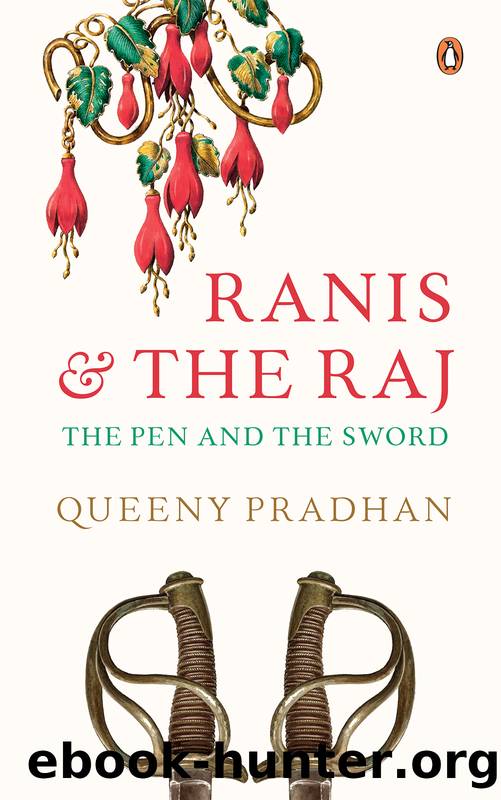Ranis and the Raj by Queeny Pradhan

Author:Queeny Pradhan [Pradhan, Queeny]
Language: eng
Format: epub
ISBN: 9789354927324
Publisher: Penguin Random House India Private Limited
Published: 2022-09-28T00:00:00+00:00
The Mughal Empire lay in ruins.
Whether Begum Zeenat Mahal was complicit with the British or negotiating with both sides is difficult to say, with accounts supporting both arguments. What limited sources are available on her convey a conflicting image of her in 1857. She was regarded with suspicion by the sepoys and the English. The accounts mostly project her as playing both sides to ensure the succession of her son. The nationalist and the imperialist historiography also look at her through the same lens.
Mainodin, a police officer at the time of the revolt of 1857 in Delhi kept a âroznamchaâ or diary of âdaily occurrences.â112 He wrote in his diary that the English were regarded as âtrespassersâ by the Indians.113 Mainodin recollected that after the entrance of the sepoys from Meerut and the killing of the English, he reached the palace, and on meeting the emperor, asked him to stop the killing. The emperor responded; âI am helpless; all my attendants have lost their heads or fled. I remain here alone. I have no force to obey my orders: what can I do?â114 Mainodin interestingly mentioned Abdulla Beg as one of the most active mutineers in Delhi. He was a Europeanâa discharged soldier of the 17th Footâwho resided at Meerut. He converted to Islam and became a leader and advisor of the king in the early days.115 Mainodin narrated how the king was completely under the control of the mutineers and, on Abdullah Begâs advice, issued a Perwanahs (notice) asking regiments to join him. He did not mention Begum Zeenat Mahal. Bahadur Shah Zafar was surprised when the sepoys from Meerut marched to Delhi on 11 May 1857, requesting him to take up the leadership, but he was reluctant and sent for Captain Douglas, the commandant of the Palace guards.116
The imperial accounts projected Begum Zeenat Mahal as a woman responsible for âmurdering those wretched survivors of the first dayâs massacre who had been imprisoned in the palaceâ.117 She was accused of driving âher reluctant husband into supporting the mutineersâ to âhave the chance to revenge herselfâ on the British.118 In Nigamâs nationalist perspective, she played a role in the Mughal emperor not agreeing to General Bakht Khanâs request to leave Delhi with him.119 The queen, it seems, was negotiating with Hodson, whom she contacted âon 18th September 1857, through Elahi Baksh and Hakim Ahsan Ullah for the Kingâs surrender provided he, she, her son Jawan Bakht and her father Ahmad Kuli Khan were guaranteed their lives. This guarantee had been given by Hodsonâ.120 According to Nigam, âThe queen played the most important partâ in preventing the Mughal Emperor from leaving Delhi and âeventually Bakht Khan retired with his troops towards Agra and thense to Lucknow.â121 Another postcolonial representation of Begum Zeenat Mahal is in the novel on Delhi by Khushwant Singh. Singh reinforced the complicity of the begum with the English authorities. He also underlined the difference between the Mughals as the representative of the âOrientâ. He described her, looking
Download
This site does not store any files on its server. We only index and link to content provided by other sites. Please contact the content providers to delete copyright contents if any and email us, we'll remove relevant links or contents immediately.
| Central Asia | Southeast Asia |
| China | Hong Kong |
| India | Japan |
| Korea | Pakistan |
| Philippines | Russia |
The Rape of Nanking by Iris Chang(3522)
The Sympathizer by Viet Thanh Nguyen(3505)
World without end by Ken Follett(3010)
Ants Among Elephants by Sujatha Gidla(2927)
Blood and Sand by Alex Von Tunzelmann(2611)
Japanese Design by Patricia J. Graham(2560)
City of Djinns: a year in Delhi by William Dalrymple(2138)
Inglorious Empire by Shashi Tharoor(2103)
In Order to Live: A North Korean Girl's Journey to Freedom by Yeonmi Park(2061)
Foreign Devils on the Silk Road: The Search for the Lost Treasures of Central Asia by Peter Hopkirk(2058)
Tokyo by Rob Goss(2022)
India's biggest cover-up by Dhar Anuj(1988)
India's Ancient Past by R.S. Sharma(1988)
The Great Game: On Secret Service in High Asia by Peter Hopkirk(1962)
Tokyo Geek's Guide: Manga, Anime, Gaming, Cosplay, Toys, Idols & More - The Ultimate Guide to Japan's Otaku Culture by Simone Gianni(1949)
Goodbye Madame Butterfly(1938)
The Queen of Nothing by Holly Black(1758)
Living Silence in Burma by Christina Fink(1732)
Batik by Rudolf Smend(1723)
